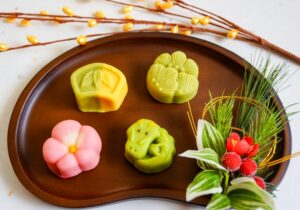Discover the Art of Wagashi: Japan’s Timeless Tradition in Sweets
What is Wagashi? A Feast for the Eyes and the Palate

Wagashi is not just a sweet treat; it is a reflection of Japan’s natural beauty, seasonal changes, and cultural heritage. These delicate confections are edible works of art, crafted with precision and designed to please both the eyes and the palate.
Imagine holding a confection that mirrors the fleeting beauty of cherry blossoms in spring or the crystalline sparkle of snowflakes in winter. Wagashi captures the essence of nature and transforms it into a sensory experience that tells a story with every bite.
A Journey Through History: Over 1,000 Years of Tradition

The origins of wagashi date back to the Nara Period (710–794), when sweets called karagashi were introduced from China. Over time, Japan refined these confections, particularly during the Muromachi Period (14th–16th century), when wagashi became an essential element of the tea ceremony.
The Role of Wagashi in the Japanese Tea Ceremony
Wagashi is not merely about flavor; it embodies the Japanese spirit of omotenashi—thoughtful hospitality. In the tea ceremony, wagashi’s gentle sweetness complements the bitter notes of matcha (green tea), creating a moment of perfect harmony.
Did you know? The principal sweet served in the tea ceremony, known as omogashi, is carefully crafted to reflect the season, demonstrating respect and care for the guest.
The Beauty of the Seasons Captured in Wagashi
One of wagashi’s most captivating qualities is its ability to showcase the changing seasons. These confections reflect the colors, flavors, and symbols of nature that define each time of year in Japan.
Examples of Seasonal Wagashi

- Spring: Sakuramochi (rice cakes wrapped in cherry leaves) and delicate nerikiri shaped like plum blossoms.
- Summer: Cooling treats like mizuyokan (translucent sweet bean jelly) and kuzumochi, which evoke a refreshing sense of water.
- Autumn: Rich flavors of chestnut in kuri kinton and maple leaf-shaped momiji manju.
- Winter: Snow-inspired yukihira and nerikiri shaped like camellias.
Wagashi is like holding a piece of Japanese nature in your hand, allowing you to experience the beauty of the seasons in a single, exquisite bite.
The Art and Craftsmanship Behind Wagashi

Each wagashi reflects the dedication and artistry of skilled craftsmen, or wagashi-shokunin. Their expertise transforms simple ingredients like sweet bean paste, rice flour, and agar into miniature masterpieces that are both visually stunning and delicious.
The Art of Wagashi-Making
Creating wagashi requires years of practice and an eye for detail. From the soft gradation of colors in spring’s nerikiri to the delicate folds that mimic flower petals, every wagashi is shaped with precision and care.
Wagashi as a Symbol of Hospitality
Wagashi expresses omotenashi, the Japanese philosophy of heartfelt hospitality. Each confection is crafted with the guest in mind—its shape, color, and sweetness are chosen to bring joy and convey a sense of connection.
Fun fact: Wagashi is often presented as gifts during special occasions, symbolizing gratitude and thoughtfulness.
Experience Wagashi: A Must-Try for Visitors to Japan

To truly appreciate wagashi, it’s not enough to see or eat it—you must experience it. When you visit Japan, immerse yourself in this unique aspect of Japanese culture:
- Visit Traditional Wagashi Shops: In cities like Kyoto and Tokyo, you’ll find centuries-old wagashi shops where artisans create masterpieces before your eyes. Try a seasonal confection fresh from the source!
- Participate in a Tea Ceremony: Discover the harmony between wagashi and matcha in a serene tea room. It’s a calming experience that brings together art, taste, and tradition.
- Taste Seasonal Delicacies: Be sure to ask about wagashi that celebrates the season of your visit. It’s an unforgettable way to savor Japan’s natural beauty.
Conclusion: Discover Japan Through Wagashi

Wagashi is more than a dessert—it is the heart of Japanese culture, expressed through art, flavor, and hospitality. Each piece tells a story of nature, history, and the care that goes into its creation.
When you visit Japan, don’t miss the opportunity to experience this edible art form. From the beauty of spring sakura to the stillness of winter snow, wagashi will leave you with a deeper appreciation of Japan’s rich traditions and aesthetic sensibilities.
Step into the world of wagashi and taste Japan’s timeless beauty—one delicate bite at a time.
